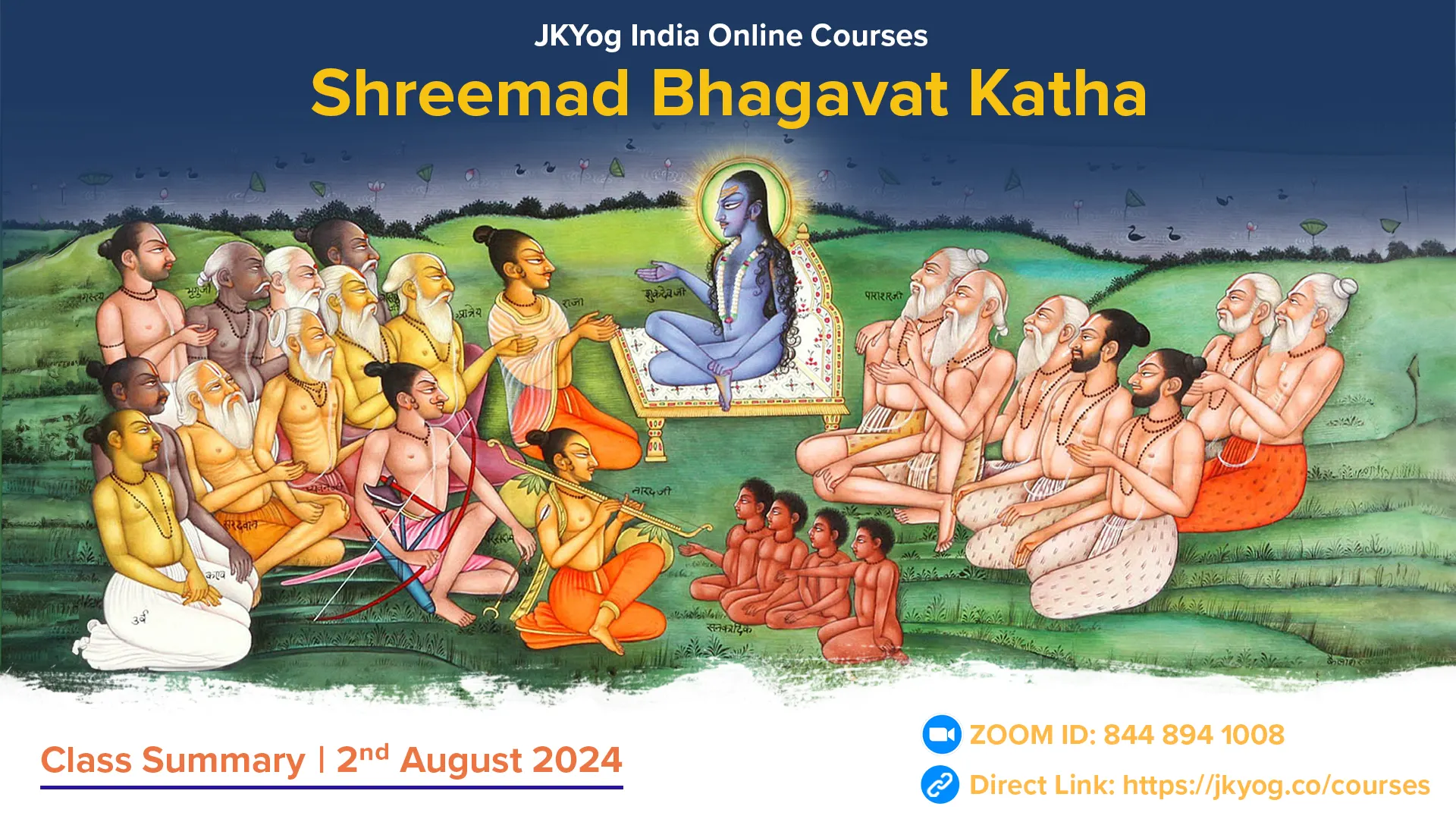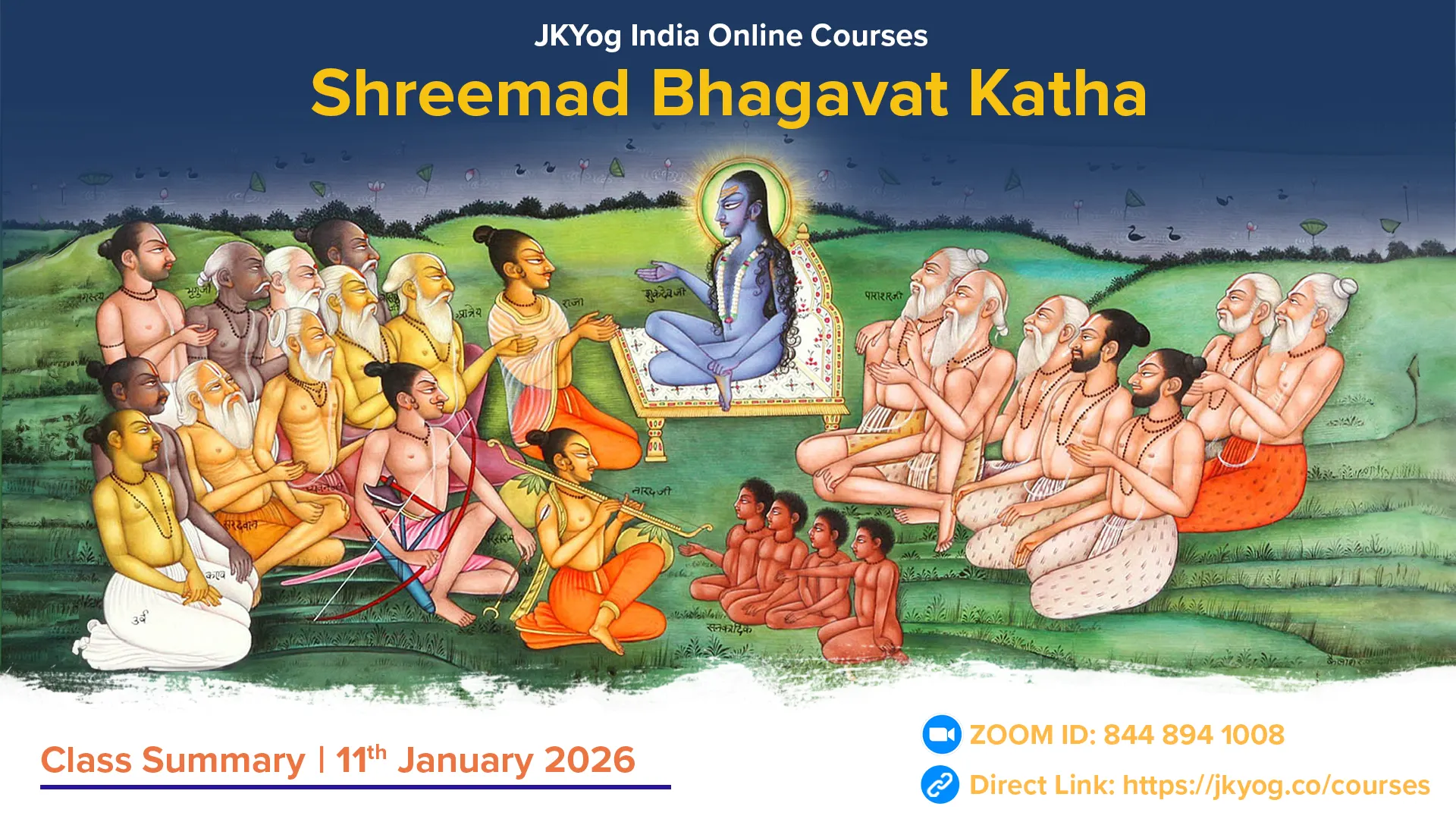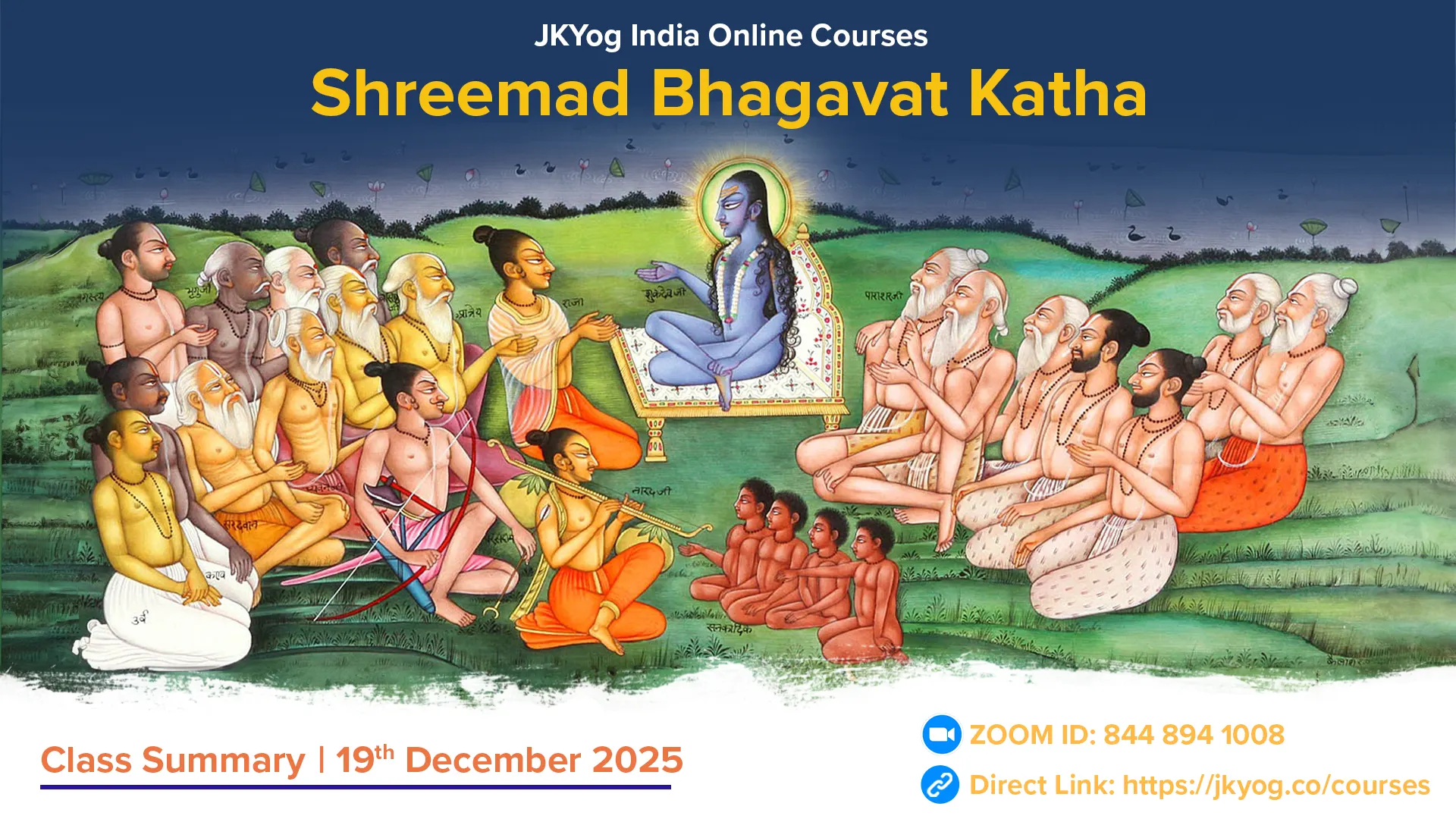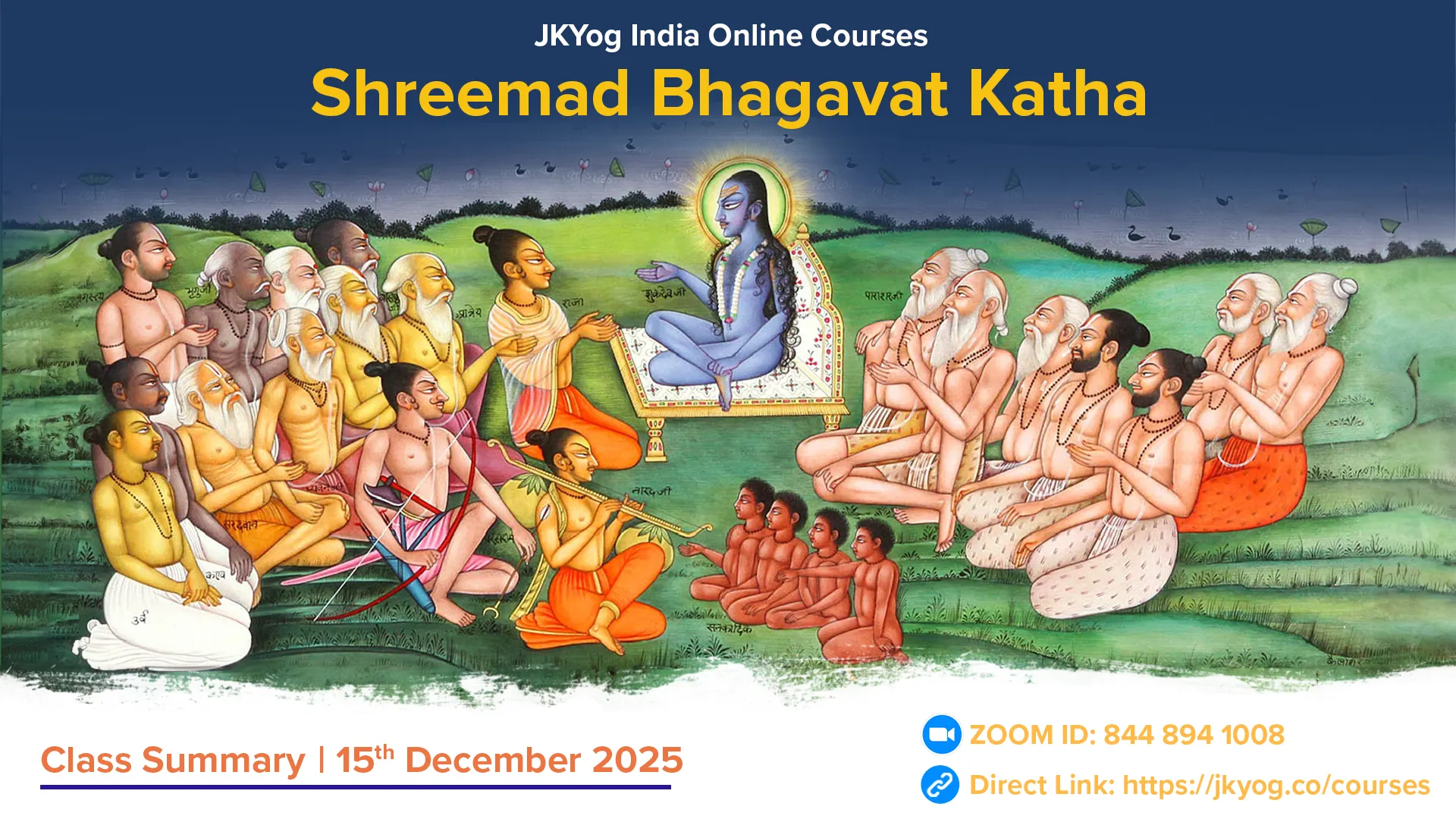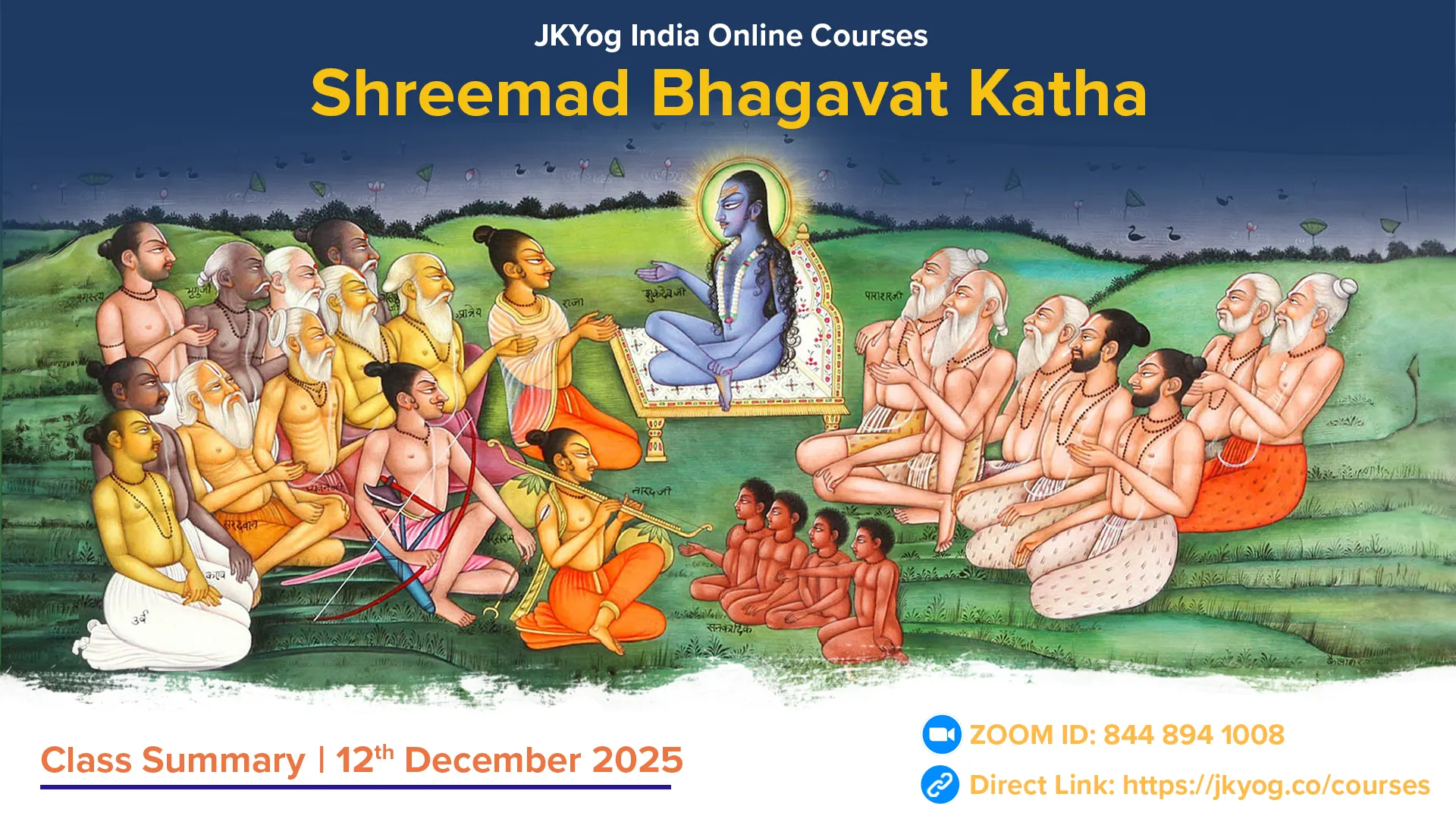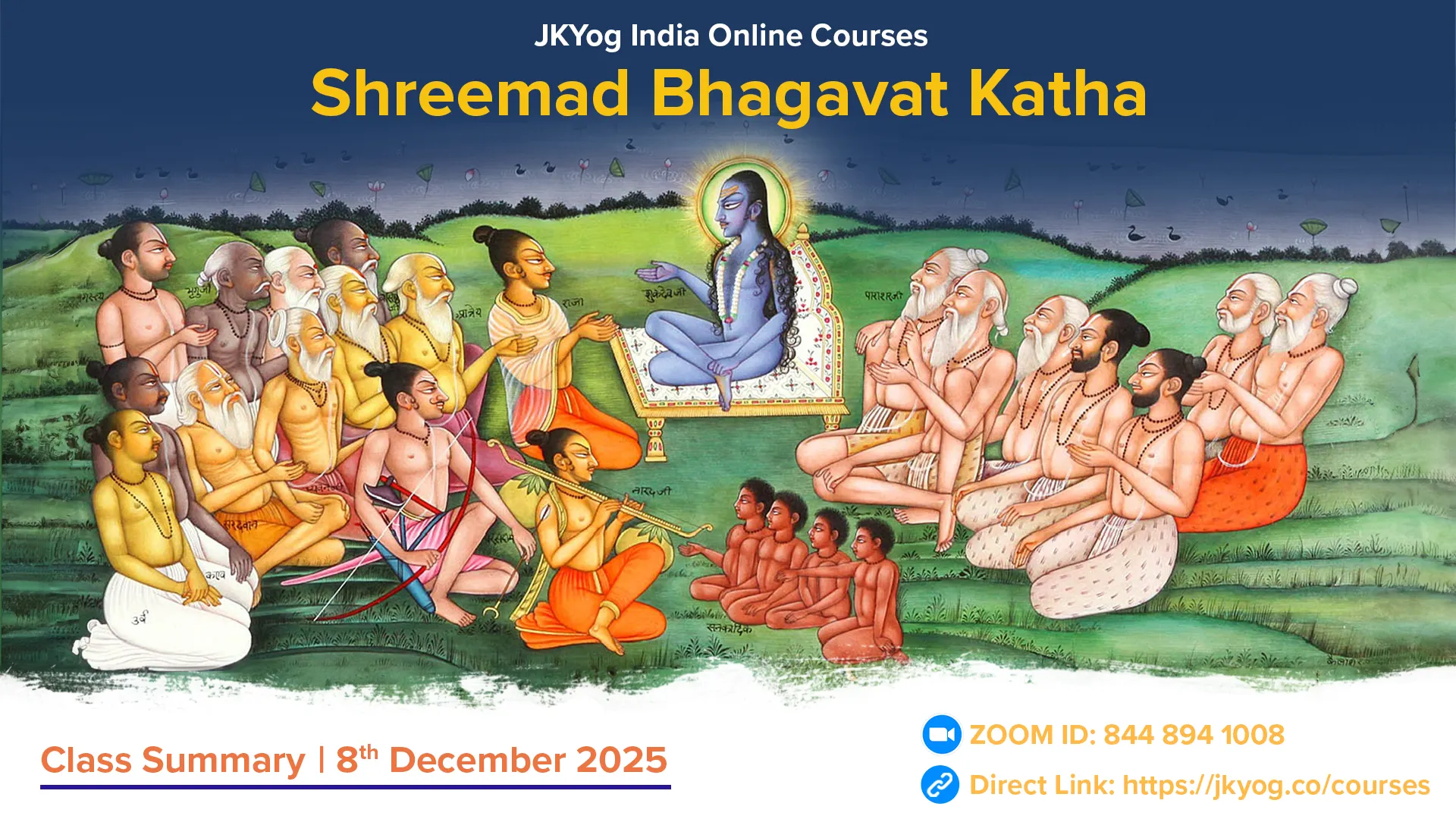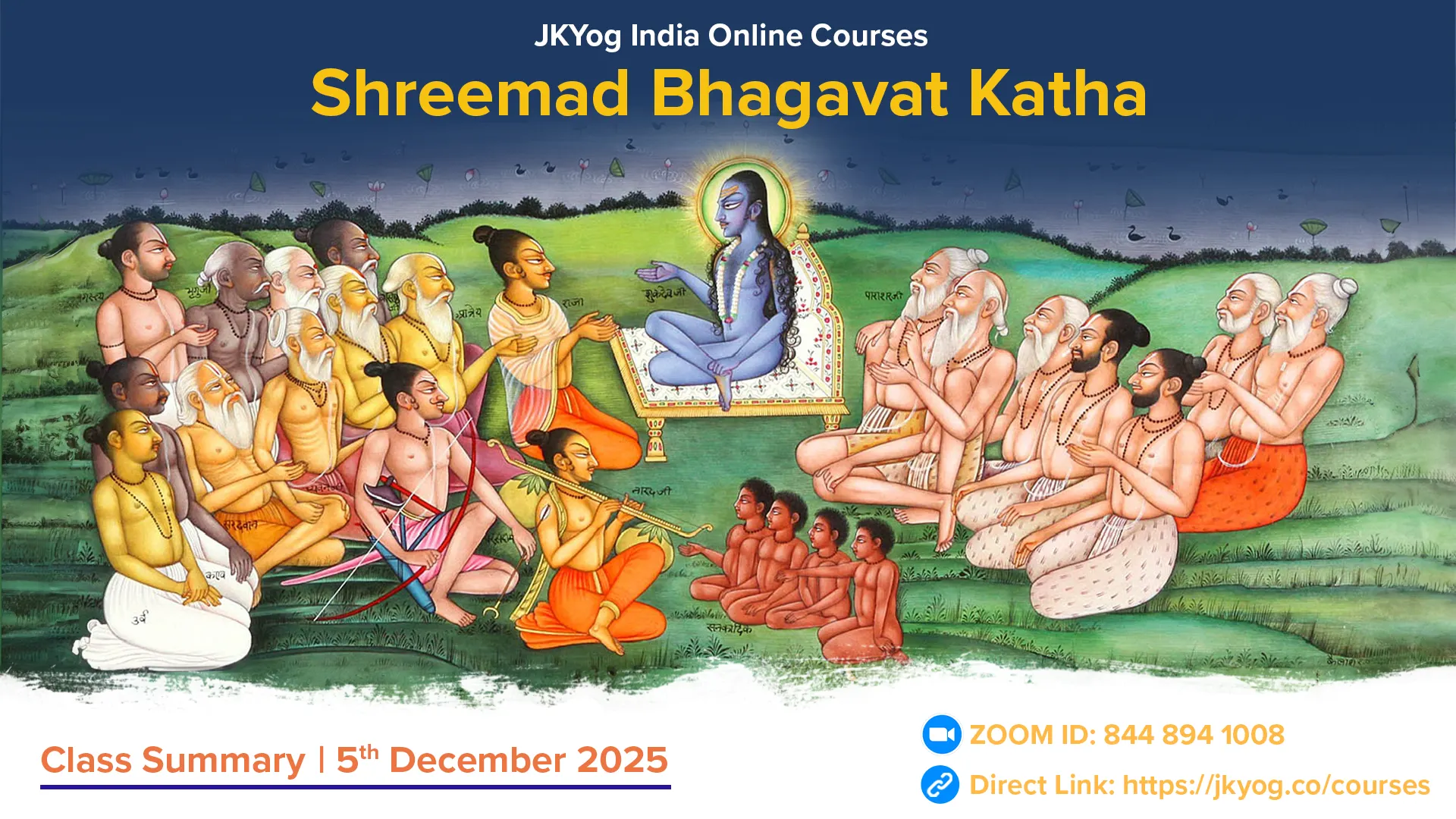Shreemad Bhagavat Mahapuran- Canto: 2, Chapters: 1 and 2
At the end of the first canto, Parikshit asks Shukadevji Maharaj the following questions:
- What should a man who is on the verge of death do?
- Whose glories should a person hear, whose names should they chant, whose pastimes should they remember, and whom should they worship? What should they renounce?
In the second canto, Vyasnandan Shree Shukadevji, who is well-versed in all dharmas, begins to answer these questions. He finds the question asked by Parikshit for the welfare of the people very appropriate. Pleased, Shukadevji says that what he is about to say is the greatest among all the things that people can hear, remember, or sing about. Those householders who are entangled in worldly affairs and do not know their true nature have countless things to talk about, listen to, think about, and do. Their entire lives are spent in this manner. Their nights pass in sleep, and their days end in the pursuit of wealth or in providing for their family. In this world, what are considered to be one's closest relations, like the body, children, and spouse, are actually temporary; however, a person becomes so engrossed in their attachment that even after witnessing them fall prey to death day and night, he does not become aware. Therefore, one who seeks the fearless state should listen to, sing about, and remember the pastimes of Bhagwan Shree Krishna, the soul of all and omnipotent.
Etavan Sankhya-yogabhyam svadharma-parinishthaya,
Janma-labhah parah punsaam ante Narayana-smritih.
Meaning: "The sole benefit of human life is to shape it in such a way, through knowledge, devotion, or steadfastness to one's duties, that at the time of death, the remembrance of Bhagwan is surely maintained." (Bhagwat 2-1-6)
Shukadevji says that even the sages and seers who worship the Nirgun-Nirakar (without attribute and form) Brahman often become absorbed in narrating countless qualities of Sagun-Sakar (with attribute and form) Bhagwan. He says, "At the end of Dwapar Yug, I studied the great scripture Shreemad Bhagavat Puran, equivalent to the Vedas, from my father, Vyas. Although I have complete faith in the formless Supreme Being, the sweet pastimes of Bhagwan Shree Krishna forcibly attracted my heart. This is why I studied this Puran. You are a great devotee of Bhagwan, so I will tell you about it."
While explaining who should listen to the Bhagavat, Shukadevji says that those who have faith in it will quickly develop pure, unwavering love for Bhagwan Shree Krishna. Those who desire anything from this world or the next or those who, having experienced the sorrows of the world, have become detached and seek the fearless state of liberation should chant Bhagwan's names with love. This is the conclusion of all scriptures for both practitioners who wish to attain liberation and the perfected yogis who possess knowledge.
Shukadevji's words carry a sense of urgency- a person who neglects their spiritual welfare and squanders even a long life of many years, unaware of the true cost. What does it truly bring? A few moments spent pursuing knowledge are far more valuable, for they pave the way for spiritual welfare. This is a call to action, a reminder of the importance of our spiritual journey.
Ore more man Radhika Raman,
Nishi din guna gan gaaye jaa.
Chin chin neh badhaye ja,
Pal pal prem badhaye ja.
Vah jeevan kya jeevan jismein, jeevandhan se pyaar na ho.
Hai vah pyaar pyaar kya jismein, piya sukh mein balihaar na ho.
Shyama Shyam milan hit nit prati, nainan neer bahaaye jaa.
During the battle between the Devas and the Asuras, King Khattvaang fought on the side of the Devas. Although the Asuras were defeated, King Khattvaang was wounded. When he asked Indra how much time he had before death, Indra revealed that only two ghadis (approximately 24 minutes) remained. In those two ghadis, King Khattvaang achieved God-realisation through devotion, showing the importance of our actions in our remaining time.
Shukadevji says, "Parikshit! You still have seven days left in your life. Within this time, do whatever is necessary for your ultimate welfare."
Antakale tu purusha aagate gatasadhvasah,
Chhindyad asanga shastrena sprihaam dehe anuye cha tam.
Meaning: "When the time of death arrives, a person should not panic. Instead, they should use the weapon of renunciation to cut off attachment to the body and to those related to it." (Bhagwat 2-1-15)
What a Person Nearing Death Should Do?
Shukadevji advises Parikshit on what a person nearing death should do:
- Yama, Niyama, Asana: With patience, one should leave home, bathe in the holy waters of a sacred place, and sit in a clean, secluded spot, placing oneself on a properly arranged seat.
- Pranava Japa: Subsequently, the person should silently chant the supremely sacred Pranava, composed of the three syllables "A, U, M."
- Pranayama: One should subdue the mind by controlling the breath, ensuring that the Pranava is not even forgotten for a moment.
- Pratyahara: With the help of intellect, the mind should withdraw the senses from their objects, restraining the mind, which is made restless by desires through contemplation and focusing on the auspicious form of Bhagwan.
- Dharana, Dhyana: Meditate on a specific organ of Bhagwan's divine form with a steady mind.
- Samadhi: By meditating on each organ in this manner, merge the mind, free of worldly desires, completely into Bhagwan so that no other thoughts remain. Upon attaining this state, the mind is filled with the bliss of divine love.
If the mind becomes disturbed by rajas or clouded by tamas during meditation on Bhagwan, one should not become anxious. With patience, it should be controlled through Yogic concentration, as concentration eliminates the defects of these two qualities. Once concentration becomes steady, the yogi beholds Bhagwan, the ultimate auspicious refuge, and immediately attains the path of Bhakti Yog.
- Pratyahara: Withdrawing the senses from worldly objects.
- Dharana: Establishing the senses on the divine object. (The word "dharana" is derived from the root "dhṛ," which means to hold, to support, or to sustain. It involves stopping the steady mind at one "place").
Parikshit then asks how concentration is practised, on which objects, in what manner, what its nature is and how it quickly purifies the mind. Shree Shukadevji explains: Having gained victory over posture, breath, attachment, and senses, one should fix the mind, with the aid of intellect, on the gross form of Bhagwan.
Jagat te man ko hata kar, laga Hari mein pyaare.
Isi ka abhyaas puni puni, karu nirantar pyaare.
Description of Bhagwan's Virat Swaroop (Cosmic Form)
The entire universe—everything that ever was, is or will be—appears within the grossest form of Bhagwan's vast and cosmic body known as 'Virat Swaroop'. The wise describes Him as follows:
Andkoshe shareere'smin saptavaran-sanyute,
Vairaj purush yo'sau Bhagwan dharanashrayah
Meaning: "In this cosmic body, surrounded by the seven coverings of water, fire, air, space, ego, the great principle, and nature, the Supreme Person, who is Bhagwan, is the ultimate support of existence; it is Him who is upheld." (Bhagwat 2-1-25)
- Virat Purush's soles are Paatal, His heels and toes are Rasatal, His ankles are Mahatal, the calves of His legs are Talatal, His knees are Sutal, His thighs are Vital, and Atal and His pelvis are Bhutal (the Earth).
- The navel of the Adipurush is called the sky.
- His chest is Svarga Loka (heaven), His throat is Maharloka, his mouth is Janaloka, and his forehead is Tapoloka.
- The heads of the thousand-headed Bhagwan are Satyaloka.
- The gods, including Indra, are His arms, the directions are His ears, and sound is His sense of hearing.
- The Ashwini Kumars are the nostrils, the smell is the sense of scent, and the blazing fire is His mouth.
- Bhagwan Vishnu's eyes are the sky, his power to see is the sun, His eyelids are day and night, and His eyebrows are Brahmaloka. Maya is considered His smile, and this infinite creation is a mere glance of that Maya.
- Horses, mules, camels, and elephants are His nails. All wild animals and beasts reside in His waist.
- Svayambhuva Manu is His intellect, and Manu's descendants, humans, are His abode.
Shukadevji explains that aspirants seeking liberation concentrate their minds through intellect on the gross form of the cosmic Bhagwan, for there is nothing apart from Him. Just as a dreamer perceives himself in various forms during a dream, the Supreme Being, who is the inner controller and experiencer of all through all intellects, is One. One should worship this Supreme, who is the embodiment of truth and the treasure of bliss, without attachment to anything else, for such attachment is the cause of the soul's downfall.
At the beginning of creation, Brahmaji received the knowledge of creation from Bhagwan, which had disappeared during the previous cosmic dissolution. This divine insight made his vision infallible and his intellect decisive, allowing him to recreate the universe as it was before the dissolution.
Certain statements in the Vedas cause people's intellect to wander in pursuit of meaningless and transient subjects like heaven and siddhis (supernatural powers). However, true happiness is never found in these fleeting objects. Therefore, a wise person should engage with material things only to the extent necessary for practical purposes.
If worldly objects are obtained without effort due to past karma, one should not exert further effort to acquire them, considering such labour unnecessary. Instead, one should lovingly worship Bhagwan, as His worship destroys the ignorance that traps one in the cycle of birth and death.
Roopdhyan Method
Bhukti na de, mukti na de, Vaikunth na de,
Naam gun gaate roop dhyan kara de.
One should patiently and with unwavering commitment focus the intellect on each part of Bhagwan's form, from His lotus feet to His smiling lotus-like face, through concentrated meditation. As the intellect becomes purer, the mind will gradually become more stable. Once meditation on one aspect is perfected, one should move on to meditate on another aspect, thus demonstrating the commitment and patience required in this spiritual journey.
Bhagwan's form is both sagun (with attributes) and nirgun (without attributes). Until one attains exclusive, loving devotion to Him, the seeker should meditate after performing daily and occasional duties, concentrating on the aforementioned gross form of Bhagwan.
Summary: JKYog India Online Class- Shreemad Bhagavat Katha [Hindi]- 02.08.2024

